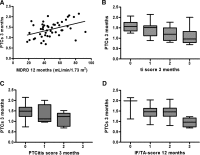Early loss of peritubular capillaries after kidney transplantation
- PMID: 21566051
- PMCID: PMC3374365
- DOI: 10.1681/ASN.2010050531
Early loss of peritubular capillaries after kidney transplantation
Abstract
Inflammation, interstitial fibrosis (IF), and tubular atrophy (TA) precede chronic transplant dysfunction, which is a major cause of renal allograft loss. There is an association between IF/TA and loss of peritubular capillaries (PTCs) in advanced renal disease, but whether PTC loss occurs in an early stage of chronic transplant dysfunction is unknown. Here, we studied PTC number, IF/TA, inflammation, and renal function in 48 patients who underwent protocol biopsies. Compared with before transplantation, there was a statistically significant loss of PTCs by 3 months after transplantation. Fewer PTCs in the 3-month biopsy correlated with high IF/TA and inflammation scores and predicted lower renal function at 1 year. Predictors of PTC loss during the first 3 months after transplantation included donor type, rejection, donor age, and the number of PTCs at the time of implantation. In conclusion, PTC loss occurs during the first 3 months after renal transplantation, associates with increased IF and TA, and predicts reduced renal function.
Figures


References
-
- Basile DP: The endothelial cell in ischemic acute kidney injury: Implications for acute and chronic function. Kidney Int 72: 151–156, 2007 - PubMed
-
- Kang DH, Anderson S, Kim YG, Mazzalli M, Suga S, Jefferson JA, Gordon KL, Oyama TT, Hughes J, Hugo C, Kerjaschki D, Schreiner GF, Johnson RJ: Impaired angiogenesis in the aging kidney: Vascular endothelial growth factor and thrombospondin-1 in renal disease. Am J Kidney Dis 37: 601–611, 2001 - PubMed
-
- Kang DH, Kanellis J, Hugo C, Truong L, Anderson S, Kerjaschki D, Schreiner GF, Johnson RJ: Role of the microvascular endothelium in progressive renal disease. J Am Soc Nephrol 13: 806–816, 2002 - PubMed
-
- Ohashi R, Shimizu A, Masuda Y, Kitamura H, Ishizaki M, Sugisaki Y, Yamanaka N: Peritubular capillary regression during the progression of experimental obstructive nephropathy. J Am Soc Nephrol 13: 1795–1805, 2002 - PubMed
Publication types
MeSH terms
LinkOut - more resources
Full Text Sources
Other Literature Sources
Medical
Miscellaneous

